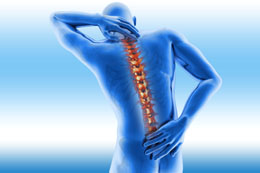Spinal cord disorders can be a very difficult condition to live with. However, educating yourself about the disorders related to it and their causes is a good way to prevent yourself from being inflicted by one! Here are a few basics about disorders and injuries that affect spinal cord...
 Was she told when she was young that pain would lead to pleasure? Did she understand it when they said that a man must break his back to earn his day of leisure? ~ The Beatles
Was she told when she was young that pain would lead to pleasure? Did she understand it when they said that a man must break his back to earn his day of leisure? ~ The Beatles
An honest man must indeed work till he 'breaks his back' in the competitive world that we are living in. But you must learn about your body and how to take care of it if you do not want to literally 'break your back'! Your spinal cord is one of the most essential organs of your body. In fact, your spinal cord is so important that out of the 206 bones in your body, 33 bones called 'vertebrae' (singular - vertebra) come together to form the vertebral column that surrounds and protects your spinal cord; that is 16% of your skeleton!
The spinal cord is nothing but an extension of the brain that runs down your back. It is divided into 5 segments - cervical, thoracic, lumbar, sacral and coccygeal. The 33 vertebrae come together to form the vertebral column. Each vertebra has a 'hole' in it; the passage formed when the 'holes' of all vertebrae are lined one on top of the other is called the spinal canal, through which the spinal cord passes. The spinal cord is wrapped up in 3 different tissues that are called the spinal meninges; the dura matter, the arachnoid matter and the pia mater.
Causes of the Disorders
As stated earlier, the spinal cord is an extension of the brain running down your back. The body is hence going to suffer severely if the spinal cord is subjected to any kind of trauma or injury, giving rise to a spinal cord disorder. The causes of spinal cord disorders can be broadly classified into 2 types, traumatic and non-traumatic.
Traumatic Causes
This occurs when the spinal cord is directly subjected to trauma. These include vehicle accidents, falling from heights, sports injuries, direct injury (for example in case of head and neck injuries, if the head and/or the neck is twisted at an unnatural angle), bleeding (this may be triggered if shards of broken bones or scraps of metal cut through the spinal cord, especially post a vehicle accident), etc.
Non-traumatic Causes
These include congenital or developmental disorders, degenerative disorders, infections, exposure to toxic compounds, inflammation, tumors, and even aging (the spinal canal narrows down causes spinal cord compression, a condition called spinal stenosis), etc.
Types of the Disorders and Diseases
Depending on the actual location of the trauma or injury, different parts of the body may be affected and different functions may be impaired. These may be broadly classified according to the nerve segment affected. In general, spinal cord injuries induce numbness, weakness, intense pain and muscle spasticity. Muscle atrophy is also seen in some cases.
1] Cervical Injuries: These typically lead to complete or partial quadriplegia. They also impair such functions of the body as breathing. Cervical injuries also affect the upper limbs - specifically the shoulders, biceps and wrists.
2] Thoracic Injuries: They affect the legs and hence commonly cause paraplegia. The abdominal muscles are also often affected. They also impair bladder functioning and may cause bladder spasms.
3] Lumbosacral Injuries: These type of spinal cord injuries usually lead to impaired bowel functioning and can cause constipation, leakage as well as bladder spasms. They also affect sexual functioning.
4] Infections: In the very rare case of a bacterial, viral or parasitic infection, common spinal cord disorder observed is transverse myelitis. It is nothing but an inflammatory disorder. Inflammation can also cause multiple sclerosis. Inflammation of the meninges can be due to several other reasons as well, including trauma. On the other hand, infection can occur in the cerebrospinal fluid (CSF) too.
Treating disorders of the spinal cord may not always be possible. However, there certainly is greater hope for affected individuals today than there was in the past. The American Spinal Injury Association (ASIA) has designated 5 Grades - A, B, C, D and E - to describe the spinal cord injury levels. It is used as a guideline while considering treatment alternatives for the affected individual.
Remember - prevention is always better than cure; so the next time you are going to drop your child off to school, or go bungee-jumping, sky-diving or trekking even, take sufficient care. Keep yourself well-informed about the risks involved in the activities you choose to participate in, because ignorance is not always bliss!


 Was she told when she was young that pain would lead to pleasure? Did she understand it when they said that a man must break his back to earn his day of leisure? ~ The Beatles
Was she told when she was young that pain would lead to pleasure? Did she understand it when they said that a man must break his back to earn his day of leisure? ~ The Beatles